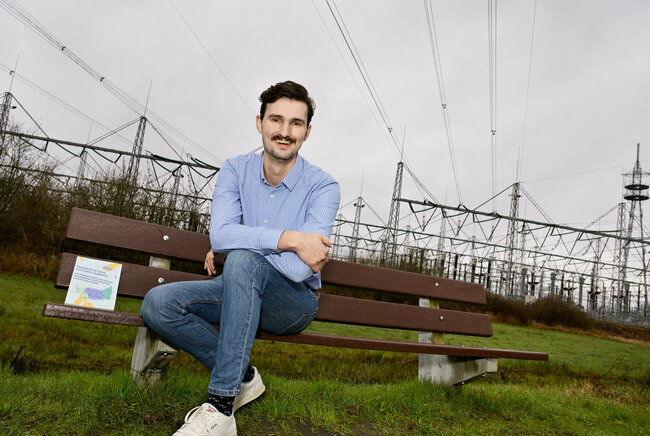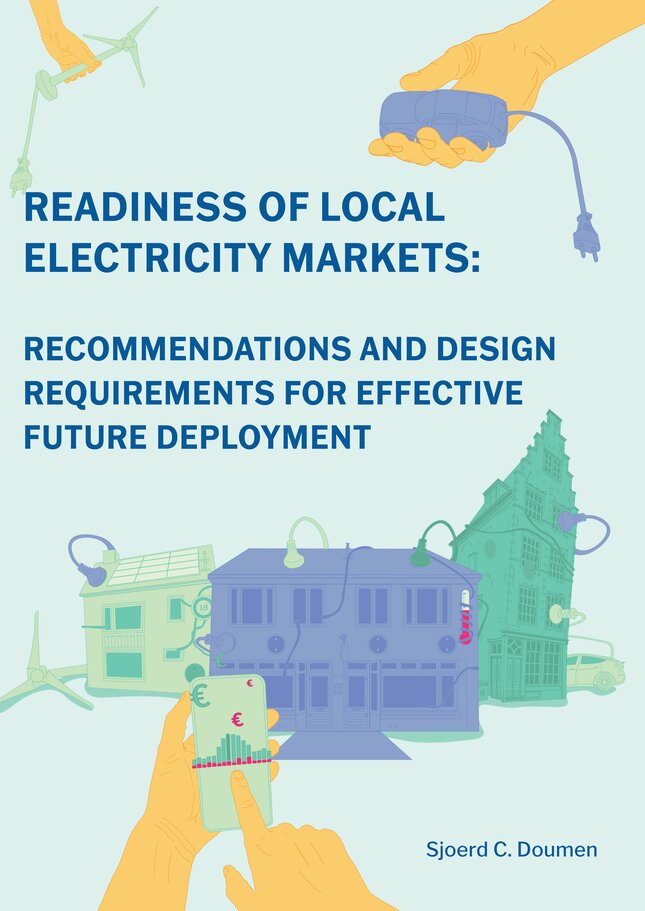Creating smaller electricity markets
Sjoerd Doumen defended his PhD thesis at the Department of Electrical Engineering on March 7th.

Our current energy systems have two major and related problems: congestion of the power grid and a mismatch between supply and demand. By switching to smaller, local electricity markets (LEMs) we wouldn’t only be able to solve these problems, but also facilitate the energy transition and make energy cheaper for everyone. TU/e researcher Sjoerd Doumen asked himself the question: are we ready to implement LEMs? Today he’s defending his dissertation at the Department of Electrical Engineering.
The current transition from fossil fuels to renewable energy sources, such as wind and solar energy, creates two major challenges. First of all, the emergence of decentral energy generation, for example using solar and wind facilities, and devices such as heat pumps and electric vehicles lead to an overburdened power grid, aka grid congestion. The second problem is the demand-supply mismatch resulting from the intermittent nature of renewable energy sources. “In the old days you’d simply switch a gas turbine on or off,” says Doumen. “Now – and even more so in the future – we’re dependent on the amount of wind and sun, and whether it’s cloudy or not. That makes it harder to match supply and demand.”
Responding to market needs
A possible solution to these problems is switching to smaller, local electricity markets (LEMs), Doumen writes in his dissertation. “At the moment, electricity is traded at the national level, with big energy corporations like Essent,” he explains. “They procure electricity at a very high level and then divide it up among many end users. The idea is to slowly transition to a situation where this is done by increasingly small parties at a more local level. Owing to better participation of end users, LEMs would be better placed to respond to market needs. For instance, we could make smarter use of solar panels and do a better job spreading out our energy usage to avoid peaks.”
Many pilots have taken place that show that you can share energy locally and that this can have many advantages. And yet, this concept has hardly been implemented in practice yet. Which is why the main question Doumen tried to answer is: are we ready to implement LEMs? His dissertation contains recommendations and preconditions that are meant to facilitate a successful implementation, taking account of the perspectives of both end users and different stakeholders, such as grid operators and energy companies. “Money is an important incentive. So if you want to get everyone onboard, everyone must be able to profit from such a system,” he asserts.
Bandwidth
One of the advantages of LEMs is that you can incorporate a local pricing component, such as a dynamic rate based on local conditions. An example of this would be the bandwidth model, where your peak usage in a certain period determines what kind of network rate you’re paying. If your usage is higher than agreed, a different rate applies.
“Tests are being run in some places. These may involve a limit to the number of watts you may use at night. If you exceed it, you have to pay a lot extra,” he says. “This means you can cook, for instance, but it won’t be enough to charge your electric car.” This encourages you to do the latter outside of peak hours, resulting in a better spread of energy usage throughout the day.
“We’re currently building the grid for two moments per day – in the morning when we get up and in the evening when we come home,” he says. “And these peaks are just getting higher, so that’s not sustainable.” You can expand the grid to allow for these peaks, but that’s not a smart solution. “That would be similar to adding extra lanes to French freeways for the two Black Saturdays a year when holiday traffic is at its worst,” says Doumen. “What we need to do is bring those two huge peaks down, freeing up a lot of space.”
More flexibility
The implementation of local electricity markets should go hand in hand with greater flexibility, Doumen says in his dissertation. “Suppose I’m charging my car, but clouds are coming. Someone could then ask me to stop and give me a small reimbursement in return.”
Netting – squaring the energy that solar panel owners buy from an energy company with the energy they return to the grid – should also be made more flexible, he thinks. “If you conclude a contract now, you purchase energy from a supplier and they buy your energy back from you. This should be made more flexible, so you have more options and can also sell it to another party,” says Doumen. “The new Energy Act (a bill for which was submitted in June 2023, ed.) also addresses this.”
Building trust
An important factor in the implementation of LEMs is the lack of trust people have, Doumen discovered. “People want security, which is why they prefer a fixed rate to a dynamic one.” This is why he thinks this trust must first be built to get people on board. “You have to properly discuss things with them and explain to them why it’s so important and why everyone will benefit.” He’s convinced that in the long run, we’ll all have to switch to a more dynamic system because it’s the smart and cheap thing to do. “A fixed three-year contract is simply out of date.”
What makes all of this difficult is that it’s not always easy to understand the advantages of a dynamic system. “It’s a bit like the COVID pandemic. Even though you’re taking measures, you still see the number of infections slowly going up, so it seems like the measures aren’t effective,” the PhD candidate says. This can be demotivating. “You see the same with energy prices. They’ll go up anyway, but more rapidly if we do nothing.”
In conclusion, the million-dollar question is: are we ready to implement LEMs? “From a technical perspective, we are, but humanity as a whole isn’t quite ready for it yet,” Doumen believes. To be successful, greater awareness must be raised for the human dimension, he asserts. In his research, he shows how we can accomplish this and how those smaller markets could work. “Whether it will look exactly like this in practice I don’t know, but one thing is for certain: we don’t have a choice, we have to head in that direction.”

PhD in the picture
What is that on the cover of your dissertation?
“They’re houses I lived in, but more than anything they symbolize the changeable nature of LEMs, where houses, solar facilities and wind turbines can be put together plug-and-play style. It shows that you always need to play around a bit to find the best solutions in any given situation.”
You’re at a birthday party. How do you explain your research?
“I research how we can make our electricity markets smaller and smaller.”
How do you blow off steam outside of your research?
“Funnily enough I cook, even though I generally don’t really like cooking all that much. But when I turn on a podcast and simply follow a recipe, it makes for complete relaxation. So after work I’d often say to my girlfriend: ‘Let me cook, so I’ll be more fun to be around when it’s time to eat.’”
How does your research contribute to society?
“Local energy markets facilitate the energy transition, thereby contributing to a greener world. And they’ll be financially advantageous to everyone.”
What is your next step?
“I’m currently working for ENTRNCE as an energy market consultant. We want to conduct several pilots to see how we can solve congestion problems using new market accessibility at a more local level. The lessons I learned during my research really come in handy in this respect.”
Title of Sjoerd Doumen's PhD thesis: Readiness of Local Electricity Markets
Promotors: Koen Kok en Phuong H. Nguyen
Media contact
Latest news


![[Translate to English:] [Translate to English:]](https://assets.w3.tue.nl/w/fileadmin/_processed_/e/0/csm_BvOF%202019_1031_BHF%20license%20TUe%20ILI%20copy_8a50884392.jpg)